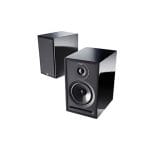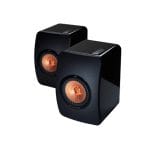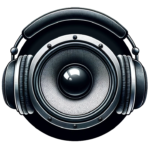Comparing Acoustic Energy 301 and KEF LS50: A Seasoned Audio Expert’s Perspective
As an experienced audiophile with countless hours spent dissecting the nuances of hi-fi equipment, I bring you a detailed comparison between two noteworthy bookshelf speakers: the Acoustic Energy 301 and the KEF LS50. Both models have garnered significant attention in the audio community, and rightfully so. However, depending on your specific needs, one may outshine the other. Let’s dive into the myriad of aspects that could influence your decision-making process.
Build Quality and Design
The first aspect that grabs attention is the build quality and design of these speakers. The Acoustic Energy 301 flaunts a minimalist, sleek design that fits well into small to medium-sized rooms. Its compact and solid build ensures its durability while maintaining a visually pleasing appearance. On the other hand, the KEF LS50 takes a more audacious approach with its UniQ driver design, which can be polarizing depending on your aesthetic preferences. The rose gold accents on the LS50 might not appeal to everyone, but the solid craftsmanship is undeniable. The KEF model also lacks bi-wiring support, which could be a drawback for some enthusiasts.
Setup and Ease of Use
The Acoustic Energy 301 scores high on ease of setup. With straightforward connection points and clear instructions, even the most tech-averse individuals can get these speakers running in no time. The KEF LS50, while not incredibly complex, does require a bit more thoughtfulness in terms of placement and configuration to optimize sound quality. If you’re someone who doesn’t want to spend too much time fiddling around, the Acoustic Energy 301 might be your go-to.
Sound Quality: A Detailed Breakdown
Bass Response
When it comes to bass response, the Acoustic Energy 301 delivers a punchy and well-defined low end. It handles low frequencies adeptly, making it quite suitable for a range of musical genres. However, in a larger room, you might find it somewhat lacking. The KEF LS50, while providing decent bass for most scenarios, doesn’t quite match up to the Acoustic Energy 301 in this department. To achieve a more immersive experience, a subwoofer might be necessary with the LS50.
Treble Detail
The treble detail on both speakers is highly commendable. The Acoustic Energy 301 offers crisp and articulate highs, perfect for those who appreciate the finer nuances in their music. However, the KEF LS50 takes treble detailing to another level. The precision and clarity it provides in the upper frequencies are astounding, making it particularly suitable for more intricate musical compositions.
Midrange Clarity
The midrange is where both these speakers shine, but for different reasons. The Acoustic Energy 301 displays impeccable midrange clarity, ensuring that vocals and instruments are well represented. The KEF LS50, however, steps it up a notch with an exceptional depth and lifelike intimacy in the midrange frequencies. If vocals and instruments are your primary focus, you might find the KEF LS50 superior in this regard.
Overall Sound Quality
Overall, both speakers offer distinctive sound signatures. The Acoustic Energy 301 provides a balanced and versatile performance, suitable for a wide array of music genres. The KEF LS50, meanwhile, adds an element of precision and openness to the sound, revealing every minute detail in the audio chain. These are not just musical speakers, but they also exhibit properties akin to studio monitors. If you’re an audiophile who values meticulous sound reproduction, the LS50 will likely resonate more with you.
Value for Money
Price is often a game-changer, and in this comparison, it plays a crucial role. The Acoustic Energy 301 speakers offer exceptional value for money. Priced competitively, they deliver a sound quality that punches well above their weight. On the other hand, the KEF LS50, while not budget-friendly, provides performance that rivals more expensive, high-end speakers. You’re essentially getting premium sound without the exorbitant price tag.
Final Thoughts
Both the Acoustic Energy 301 and KEF LS50 are stellar choices in the realm of bookshelf speakers, each excelling in different aspects. Your choice ultimately boils down to what you prioritize more: a balanced, value-for-money option with the Acoustic Energy 301, or a more precise, detailed, and slightly more premium experience with the KEF LS50. Either way, both speakers offer remarkable performance and are worthy additions to any audiophile’s collection.
Comparing Aspects
User-Based Scores & Our Experts Analysis
KEF LS50
Acoustic Energy 301
The bass response of the Acoustic Energy 301 is quite impressive for its compact size. It delivers a punchy and defined low end, adequate for most musical genres. However, its performance can be underwhelming in larger rooms. The KEF LS50, while accurate, lacks the same depth in the low frequencies. It offers decent bass suitable for most scenarios but might leave bass enthusiasts yearning for more. A subwoofer may be necessary to reach more immersive low-end performance in the KEF LS50.
Aspect Verdict:Overall, the Acoustic Energy 301 emerges as the better option for bass response, particularly in smaller to medium-sized rooms, unless you are ready to invest in a subwoofer to complement the KEF LS50.
In terms of treble detail, the Acoustic Energy 301 is impressive, delivering crisp, articulate highs that enrich the listening experience. It ensures that the high frequencies remain clear without becoming harsh. On the other hand, the KEF LS50 excels in this department. The KEF's treble performance is sharp, almost surgical in its precision. It brings out every tiny detail, making it especially suitable for intricate musical compositions that rely on upper-frequency instruments.
Aspect Verdict:If you prioritize treble detail and clarity, the KEF LS50 is undoubtedly the winner in this category. It offers a level of precision that the Acoustic Energy 301, while excellent, just cannot match.
For midrange clarity, the Acoustic Energy 301 offers an engaging listening experience with vocals and instruments coming through with remarkable clarity. It's easy to differentiate between different elements in the mix. However, the KEF LS50 takes it a step further. The midrange on the KEF LS50 is exceptional, providing depth and intimacy that makes you feel like you're in the same room as the performers. It excels in rendering vocals and instruments with lifelike precision.
Aspect Verdict:The KEF LS50 edges out the Acoustic Energy 301 in terms of midrange clarity, offering an additional layer of depth and intimacy that truly enhances the musical experience.
The Acoustic Energy 301 flaunts a sleek and minimalist design, suitable for most décor styles. Its compact size and solid build make it a versatile option for small to medium-sized rooms. The KEF LS50, on the other hand, features a more audacious UniQ driver design, which can be polarizing. Its rose gold accents and solid craftsmanship make it a standout piece, albeit with limited color options. Both speakers are well-built, but the KEF LS50 might not appeal to everyone aesthetically due to its bold design choices.
Aspect Verdict:Both speakers score well in design, but your choice will depend on personal aesthetic preferences. If you lean towards minimalist and compact, Acoustic Energy 301 will serve you well. For those who appreciate bold designs and are fans of the UniQ driver aesthetics, the KEF LS50 will be more appealing.
Both speakers shine in overall sound quality but cater to different listening preferences. The Acoustic Energy 301 offers a balanced sound with good bass, clear mids, and detailed highs. It is versatile and can handle various music genres effectively. The KEF LS50, however, brings a sense of precision and openness that reveals every minute detail within a track. It combines musicality with accuracy, presenting an almost transparent audio experience. While the Acoustic Energy 301 is a solid performer, the KEF LS50 adds an extra layer of complexity and detail that audiophiles crave.
Aspect Verdict:If you are looking for balanced, versatile performance, the Acoustic Energy 301 is a fantastic choice. However, if you prioritize precision and intricate detail, the KEF LS50 is the superior option.
In terms of value for money, the Acoustic Energy 301 stands out. It is priced competitively and delivers a level of performance that exceeds its cost. The KEF LS50, although more expensive, offers a performance that rivals higher-end speakers, making it a bargain at its price point. Both speakers represent excellent value propositions in their respective price categories.
Aspect Verdict:For those on a budget looking for excellent performance, the Acoustic Energy 301 is the go-to. However, if you’re willing to invest a bit more, the KEF LS50 offers a premium experience that justifies the cost.
Final Verdict
In comparing the Acoustic Energy 301 and KEF LS50 speakers, there are numerous factors to consider, each catering to different preferences and setups. The Acoustic Energy 301 proves to be an all-around strong performer, excelling particularly in value for money and ease of setup. It delivers a balanced and versatile sound suitable for various music genres and smaller to medium-sized rooms. The KEF LS50, however, stands out with its precise and detailed sound, exceptional midrange clarity, and sleek, albeit polarizing design. Its performance rivals that of higher-end speakers, making it a more premium option in terms of sonic excellence. Both speakers offer unique qualities, making them suitable for different listener profiles and audio setups.
Comparison and Difference Between
Use dropdown menus to compare different models.
| Compare Speakers |
Brand and Model Specifications
Information about the brand, model release date.
| Manufacturer | Acoustic Energy | KEF |
| Model | 301 | LS50 |
| Photo |  |
 |
| Release Date | 2013 | 2013 |
| HifiSpecs Rating | ||
| Amazon Rating | ||
| Price |
Technical Specs
Technical characteristics of the speakers.
| Amplification Type | Passive | Passive |
| Crossover Type | 2-Way | 2-Way |
| Enclosure type | Slot port | Bass Reflex |
| Frequency Range (+/-3 dB)[Hz] | 48 - 32000 | 79 - 28000 |
| Frequency Range (-6dB)[Hz] | - | 47 - 45000 |
| Maximum SPL [dB] | - | - |
| Sensitivity (2,83 V/1 m)[dB] | 87 | 85 |
| Nominal Impedance (Ohms) | 8 | 8 |
| THD (Total Harmonic Distortion) | - | - |
| Recommended Amplifier Power [W] | 25 - 150 | 25-100 |
| Crossover Frequency [Hz] | - | 2200 |
| Bass Reflex Tuning Frequency [Hz] | - | - |
| Driver Units | Tweeter: 1 x 28 mm (1-1/8 in.) fabric dome |
Tweeter: Uni-Q driver array with 1″ (25mm) vented aluminum-dome tweeter |
| Connectivity | Wired | Wired |
| Inputs | Single Wire | Single Wire |
| Outputs | - | - |
| Magnetic Shielding | No | No |
Placements and Distances
Where and how to put them.
| Form Factor | Shelf, Stand | Shelf, Stand |
| Distance from Wall [cm] | 20 | 15 |
Dimensions and Weight
Physical characteristics of the speakers (without stands).
| Length | ~ in ~0 mm ~0 cm |
~7.9 in ~200.66 mm ~20.07 cm |
| Width | ~185 in ~4699 mm ~469.9 cm |
~10.9 in ~276.86 mm ~27.69 cm |
| Height | ~ in ~0 mm ~0 cm |
~11.9 in ~302.26 mm ~30.23 cm |
| Weight (Single Speaker) | ~5.5 lb ~2494.76 g ~2.49 kg |
~15.8 lb ~7166.76 g ~7.17 kg |
| Shipping Weight | ~11 lb ~4989.52 g ~4.99 kg |
~40.4 lb ~18325.13 g ~18.33 kg |
Colors and Accessories
List of available colors and optional accessories.
| Colors |
|
|
| Accessories | – |
– |
| Detachable Grilles | No | No |
Price and Warranty
Satisfaction is (not) guaranteed.
| Warranty | 3 Years | 5 Years |
| Amazon Price |
Review Comparison
Hifispecs' professional customer-reviews can help make up your mind.
| Available Reviews |
Disclaimers
Small print and stuff...
The data and facts on this website are provided on "as is, as available basis" without warranty of any kind. HiFiSpecs.com is not responsible for any errors and possible mistakes in the information it publishes. Double check all the information directly on the manufacturer sites.
HiFiSpecs.org is a participant in the Amazon Services LLC Associates Program, an affiliate advertising program designed to provide a means for sites to earn advertising fees by advertising and linking to amazon.com, amazonsupply.com, or myhabit.com.
We do not endorse any product or service for money.

